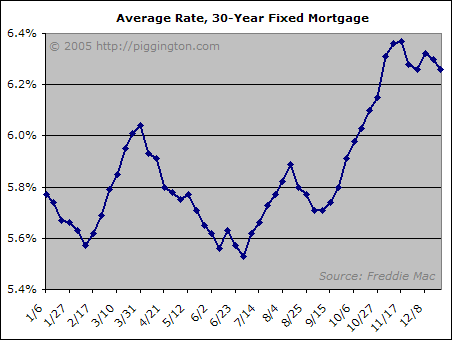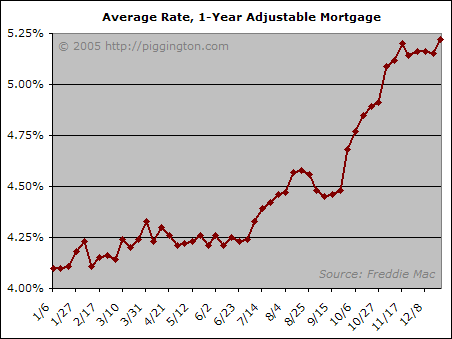The markets got all atwitter because the Fed dropped the word "accommodative" from its latest post-meeting statement. Does the change in wording imply that the rate hikes will soon be over? This question will be discussed below, along with some thoughts on fixed and adjustable mortgage rates, inflation indicators, the new federal lending guidelines, and how all of the above will affect the housing market.
Let’s start with a look at recent mortgage rates:


While the long term rates have eased back a little in recent weeks, ARM rates headed back up to surpass (slightly) their recent highs. As I say every month (forgive me; it’s for the new readers) and I will say again: adjustable rates are much more important to us because 80% of San Diego homebuyers use ARMs. And ARM rates have now risen 112 basis points since the beginning of the year—an increase of 27%.
Let’s look at this another way. If a hypothetical buyer had an upper limit of $2,000 per month to pay towards a mortgage, he could (assuming no down payment for simplicity’s sake) have purchased a $415,000 house at the beginning of 2005. At today’s ARM rates, the same buyer with the same $2,000/month limit could not afford a house selling for more than $365,000. That’s a 12% decrease.
So why haven’t home prices declined by 12%? There are a few reasons. One is that long-term rates have not risen as sharply as ARM rates, so the 20% of buyers using long term rates hasn’t experienced the decrease to their upper-limit price tag. Another is that real estate prices are very slow-moving and thus not as volatile as interest rates.
But the third and most important reason is that people have turned to ever-more risky loans in order to lower that initial down payment. We’ve discussed such loans before: negative amortization loans where borrowers exchange a lower payment up front for a much higher payment down the road. It is only through instruments like these that prices have been able to remain at a level where the top 9% of income earners are the only ones who can "afford" the median priced home, per CAR’s Affordability Index. And that’s why I spend so much time nerding out on this credit market stuff.
In short, rates have gone up a lot but there has not been a commensurate effect on home prices because people have used neg-am loans to offset higher payments. So far so good, but when does it end? Maybe soon. As I discussed in the article entitled "Is This the End of E-Z Credit?," several federal regulatory agencies have put together some very thorough "guidance" on the level of risk that banks can take when issuing non-traditional mortgages. Had these new regulations been issued three years ago, they likely would have put a damper on the burgeoning speculative mania and ensured a soft landing for real estate. Unfortunately, as I’ve written about at length, there is very little hope for a soft landing at this point. These regulations are too little, too late, and if they are strictly enforced they may actually hasten housing’s downward correction. Simply stated, if all these rules were put into place in San Diego, it would knock a lot of potential buyers out of the market, and reduce the maximum home price tag for many more. Then we’d really start to see the effects of those rising rates pictured above.
We’ll have to wait and see how strictly the new guidelines are enforced, and over what timeframe. This could be a big development, though. And while we may not know exactly how bad these regulations will be for the housing market, we know they won’t be good.
Let’s turn now to the Federal Reserve: will they ride to the rescue and stop raising rates? Wall Street seems to think so, as the Fed changed the wording in their post-FOMC meeting statement to indicate that they no longer necessarily viewed current conditions as "accommodative." Myself, I’m not so sure. As I’ve written before, the Fed is more concerned about inflation expectations than practically anything else. And with gold over $500 per ounce and the most recent Consumer Confidence survey showing anticipated inflation at 3.1% over the next year, I think that inflation expectations are still a bit too high for Fed comfort. This could change in the months ahead, of course, but as things stand today, my guess is that the Fed will feel compelled to keep hiking.
So, the Fed’s still hiking, ARM rates are rising, and lending regulators have their britches in a bunch. Credit conditions are most assuredly tightening. And this is bad for housing, plain and simple. Real estate prices are, as I said, slow to move, and for the time being I imagine that the housing market will continue the recent trend of lower sales volume and flat to slightly-down prices. But if this trend towards tighter credit continues apace, we will start to see some more notable price deterioration in the not-too-distant future.
